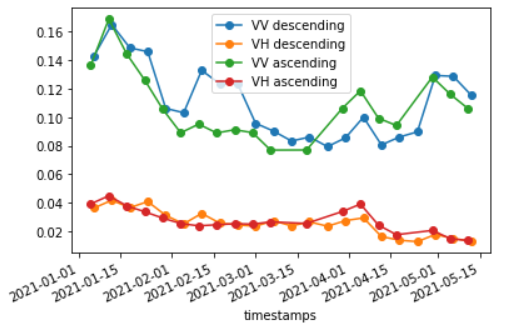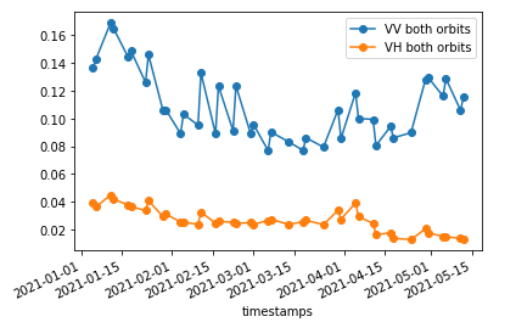Hi!
A few months ago, I asked about some specifics about Sentinel-1 orbits (here). Among those questions, we were wondering if data should be separated by orbit or not, as the bibliography said that orbit in non-plane topography impacts data.
We observed that in several cases of ours, for example as below:
We can see that ascending and descending VV/VH are sometimes quite different, particularly VV (for example around half of february). There is another example in the topic I linked earlier.
A descending and an ascending pattern can be seen in both bands, i.e. VV and VH. For instance, descending data has one spike in late january and in mi-february, but is lower than ascending variables starting around may. So at least it seems logical from this pov.
When we call for both orbits without separating them, we obtain the following graphics:
You can see that the signal with both orbits seems unstable and rather spiky as expected (for example around mid-february, once again).
We got the data using sentinelhub package in Python. The data is from the data collection SENTINEL1_IW, GRD_data (VV and VH) and GAMMA0_terrain using the DEM from Copernicus for terrain flattening. A Lee filter is applied in the SentinelHubInputTask. Our ROI is in Morroco, thus we have both orbits with a revisit time of maximum 6 days. It seems that our ROI is rather flat, but is occupied with crops (agricultural land).
Our interrogations are about how to either use or filter the data so it can be usable:
- I understand that the orbit (i.e., how the satellite “arrives” in the ROI -either North to South or South to North) impacts the signal due to the topography and what is present on the ground. How much does the terrain correction help with that?
- In my last topic, it was advised to use each orbit separately. I understand where this comes from, but to use 2 VV and 2 VH for modelling other variables is unfortunately not very usable. Does anyone have an insight on what could be done ? We understand that averaging is not optimal (and maybe even incorrect?). We thought of making a filtering (with a butter filter for instance) when the difference between ascending and descending is too high, but ultimately it’s all the same problem as averaging. We have two different values and neither are wrong since they’re observations. Does anyone have experience about using only one VV or VH variable with both orbits?
We tried to look up this topic on the forum and elsewhere but could not find any answers, unfortunately.
Thank you for reading me!

